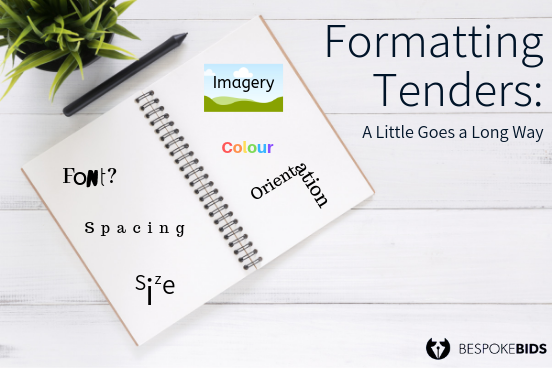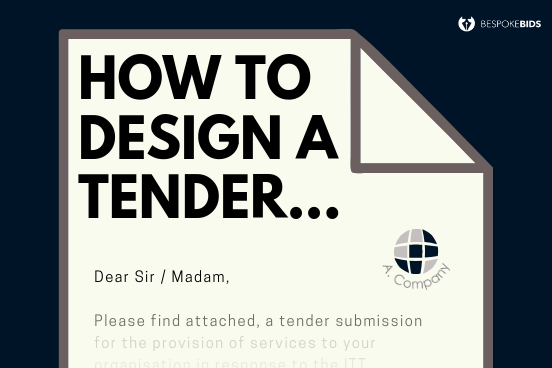
Document formatting in general is obviously a very broad topic. Every aspect has been discussed and debated before and we don’t expect to cover much new ground here. Instead, our aim in this blog is to provide some very basic guidance on how you might approach formatting your tender submissions. A little bit of thought here can go a long way towards success.
Depending on whether you are submitting to private or public sector clients, generally speaking you will either:
- Have to complete one or more documents and return them as they are.
- Need to create your own response document for submission.
Completing Client Documents
In the public sector the vast majority of clients will publish pre-formatted tender documents for you to complete. Don’t forget to read the instructions on how to complete them as there may also be requirements around typeface, font size, line spacing and document format (i.e. PDF/Word or both).
If there are any issues with the documents or their pre-defined formatting, especially if these issues prevent you from writing a compliant bid, ask for clarification as soon as possible.
Do not ignore any instructions you may be given, as you may well be rejected.
Completing Client Portals
Increasingly, buyers are using online portals and questionnaires for tender submissions where responses must be placed in boxes with pre-set character or word limits. When text is placed in the boxes most formatting is removed. Typically this will include:
- Bold, italicised, underlined or coloured text.
- Bullets may also appear differently to those in your Word document and could occupy a different number of characters.
You will usually need to go through each response box after you have entered your text, to neaten up line spacings and indentations etc.
In addition the following cannot usually be placed in boxes on the portal:
- Images and graphics
- Tables
- Text boxes
- Embedded documents
- Hyperlinks
Graphics and Tables
If you have graphics or tables you wish to include, check the instructions about attachments. It may be that you could include the graphic or table as a separate attachment and refer to it in the relevant response.
Word/Character Count Glitches on Portals
A common “glitch” on this kind of portal is removing text because it “thinks” you have exceeded the limit.
- Character Limit Boxes
If part of your response is missing, you will need to go through and remove erroneous additional spaces, punctuation marks, bullet points and line spacings. If these don’t bring your response under the limit, you’l need to edit the text itself.
- Word Limit Boxes
If you have lost some text here, the only solution will to edit your text down. This can be frustrating, if you know you’re not over the limit, but you should always be able to reduce your word count sufficiently without sacrificing quality.
Creating Your Own Response Document
If you need to create your own submission document, again double check that there are no requirements with regards to structure. Look for:
- Numbers of pages you are allowed
- Typeface and size
- Spacings
- Margins
Again, failing to follow these instructions could result in a rejection.
Once you have clarified if there are any rules you have to follow you can now concentrate on creating your document. Here are some simple formatting guidelines to follow.
Structure
Keep it simple. If there are no rules about how the document should be structured, just follow the structure of the questionnaire and the questions. This will make it easy to read and navigate.
Contents List
Always include a contents list but don’t include too many sub-layers if possible. No one want’s to keep track of “Section 4.6.3.1” in your content’s page.
Layout
It’s a good idea to imagine your document as it will look printed off. This will help to make sure that things like the contents list and any divider pages are on the right hand side as they would be in a book. Getting this right is essential if you are submitting a hard copy.
Don’t include isolated bullet points or sentences at the end of a page.
Use page or section breaks to keep specific sections together.
Don’t have tables running continuously over several pages. Split it up and repeat the column titles on each part of the table.
Graphics and Images
Graphics should be readable and images should be high-resolution wherever possible. Also try not to have these located on a turnover isolated from the text they are connected with. Ideally have them on the same page or on the opposite page if possible.
Branding
Whilst you will obviously want to have your own branding on the document it is good practice to try and reflect the branding of the client in some way too. Incorporate their colours in graphics and fonts for example. Place their logo in the header or footer and on the front cover.
Portrait or Landscape?
Again if there are no specific instructions then this is entirely up to you. Landscape layout is particularly good if your tender has a lot of visual content or contains drawings or sketches.
Try to avoid using a portrait layout with a lot of graphics, images or tables. Don’t place tables sideways in order to fit them on. You should make the evaluator’s life as easy as possible. You won’t do yourself any favours if they have to frequently turn the document round (on screen or physically), to read what is on the page.
Spelling, Punctuation and Grammar
Back away from the Spellcheck! Or indeed any other checking feature of Word. None of these features pick everything up. Read the document through and simply correct as you go.
If you’re interested in learning more about tender structure and design, click below for a more in-depth post on document design.

Did you enjoy this post?
Follow Bespoke Bids on Linkedin to keep up with our day-to-day operations. We post live tenders, tips and tricks and more.


